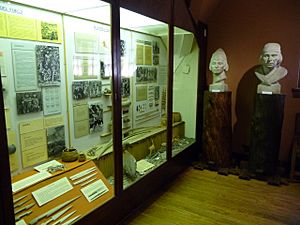Francisco Moreno Museum of Patagonia facts for kids
The Francisco P. Moreno Museum of Patagonia is a cool place in Bariloche, Argentina. It's a museum that teaches you about the natural world and different cultures. You can find it in the city's main area, called the Civic Center.
Contents
History of the Museum
The museum first opened its doors on March 17, 1940. It was part of a bigger project to open the Bariloche Civic Center. The government wanted to help this faraway Río Negro Province town grow, especially as a ski resort.
An architect named Ernesto de Estrada designed the museum. He also designed the Domingo Sarmiento Public Library and the Bariloche City Hall. These buildings are made from strong green rock called tuff, and wood from cypress and fitzroya trees. Their roofs are made of slate. All these buildings are around a main square paved with flat stones called flagstones.
What You Can See: Museum Collections
The museum is named after a famous Argentine explorer and scientist, Francisco Moreno. Many of its first collections came from the National Parks Administration. The museum was set up in a similar way to the La Plata Museum, which Moreno also helped start in 1888.
The museum was updated and made more modern in 1992. Its collections are now organized into different rooms, each with a special theme:
Natural Sciences Hall
This part of the museum shows off amazing fossils and cool rocks. It helps you learn about the geology of the area.
Prehistory Hall
Here, you can see detailed dioramas that show what life was like long ago. There are also displays about different layers of rock, called stratigraphy. You can also see tools and items from Stone Age cultures that lived in this region.
Aboriginal History Hall
This section teaches you about the native groups of Patagonia. These include the Mapuche, Selkʼnam, Tehuelche, and Yámana cultures. You can see tools they used, even some for studying the stars!
Regional History Hall
This area tells the story of Patagonia from when the Spanish first arrived. It covers history all the way up to the time of the Argentine War of Independence.
San Carlos de Bariloche Hall
This part of the museum focuses on the local history of Bariloche. It shows how the town started in 1885. It also explains how it grew with help from people like Public Works Minister Ezequiel Ramos Mexía after 1905.
National Parks Hall
Here, you can find documents, maps, and diagrams about Argentina's National parks in Argentina. Bariloche's own Lake Nahuel Huapi was actually the country's very first national park!
Francisco Moreno Hall
This special exhibit honors the museum's namesake, Francisco Moreno. He was a famous surveyor and scientist. In 1903, he gave the land around Lake Nahuel Huapi to create Argentina's first national park.
The museum also has a space for temporary exhibits that change often. There's an auditorium for events, a workshop, a library, and archives. It also has special areas for the people who take care of the collections, called curators, and for researchers.
In 1987, the Bariloche Civic Center, including the museum, was named a National Historic Monument. This means it's a very important historical place in Argentina.
See also
 In Spanish: Museo de la Patagonia para niños
In Spanish: Museo de la Patagonia para niños



